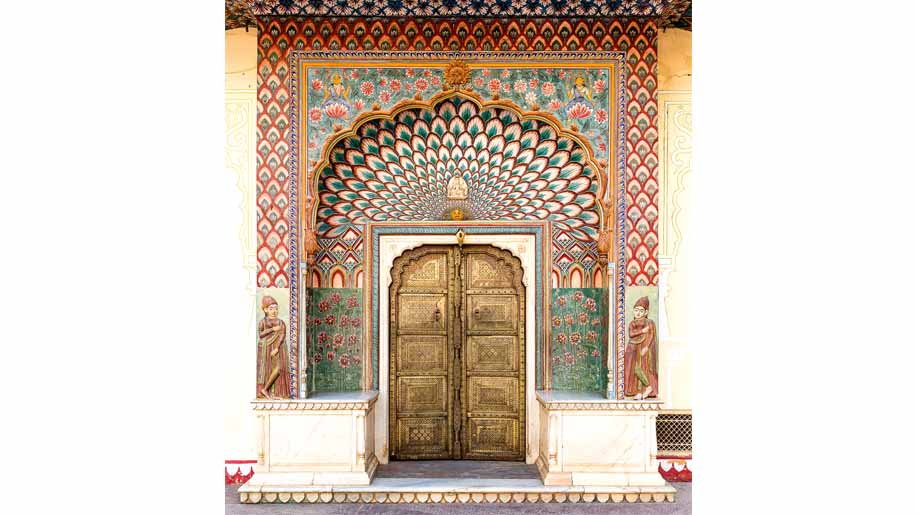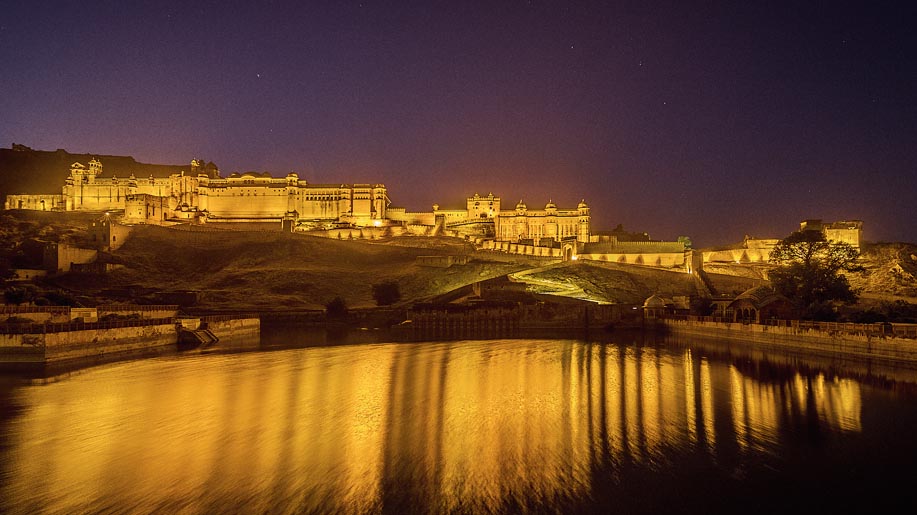
Rich heritage, traditional street food and traces of ancient culture visible even today in Rajasthan’s capital, receive less credit than they are worthy of. Though most of the city’s palaces need much restoration, dig into their history and you’ll see them for what they truly are — magnificent. Even though the local fare can be heavy for the untrained stomach, indulge in a sampling because this play of spices on the taste buds is unique to the region. There is a certain charm to the chaos — cars in a perpetual rush, stray cows, impatient pedestrians, and carefree two- and three-wheel cycles. They may not think much of traffic rules, but have an unsaid, polite understanding that helps them manoeuvre through the traffic in tandem with each other.
For first-time visitors, it’s either a hit or a miss. Let’s just say, Jaipur is an acquired taste for a handful, such as me, who are a regular to the city; give it time and the city could grow on you too.

PALACE
City Palace is one of the few in Jaipur that has been well maintained from the time it was erected by Maharaja Sawai Jai Singh II in 1727. One of the reasons could be that to date, it is a living palace, closely watched over by its residents. Within the gated compound, the royal house is surrounded by buildings some of which are museums and art galleries, open to the public. One of them has an elaborate display of textile swatches, embellished attire and costumes that have been part of the palace since the last three centuries. Another section has a collection of the palace’s arms and armour — swords, shields, bows and arrows, and firearms to name a few. And a third holds a beautiful showcase from the treasures of Maharaja Sawai Ram Singh II “and his contemporaries”. They include grand chandeliers, manuscripts, carpets, and maps and plans. Sabha Niwas or the reception hall is decorated with “original furniture, artworks, lights and a special display of ceremonial garments and medals”.
One of the more noteworthy details of them all are the four entrances of Pritam Niwas within the palace grounds. They’re painted to appear as 3D images. One has feathers of our national bird — the peacock, the second doorway has lotus petals, there are rose motifs and petals on the third, and a green geometric pattern on the fourth doorway. Inside, there is yet another detailed exhibit of royal artefacts, watched over by guards in Rajasthani attire. For enthusiasts of automobiles, there is a “garage” with noteworthy vintage cars owned by the royal house.
Expect to spend an easy three hours here — the well preserved items are a sight to behold.
• Open Monday-Saturday 10am-5:30pm; ticket price starts from ₹130 for Indians and ₹500 for foreigners; thecitypalacejaipur.com

FORT
Large ramparts and cobbled pathways lead to the opulent Amer (or Amber) Fort amongst the Aravalli hills. It is built with yellowish-pink sandstone and the interiors have marble with ornate etchings, influenced by Hindu and Muslim cultures. Amongst its four spacious courtyards, one has the Siladevi temple with gorgeous carvings on its silver doors. It is surrounded by high windows with latticework screens through which women used to watch soldiers returning from war. This detailing continues in the second courtyard with alabaster work and marble lattices. The Maharaja used to hold a private audience here. You will find ostentatious artwork in the third courtyard that includes painted columns, mirror work on ceilings, coloured glass and inlaid interiors. Through the fourth courtyard one can visit opulent rooms occupied by the Maharaja’s many concubines and wives.
My first time here was around sunset, just before the astounding sound and light show was about to begin. The visual storytelling brings Amer’s rich history to life through a stunning play of colourful lights and soothing instrumental folk music. It throws light, and quite literally, on the grand lifestyles of Amer’s royal family — highlighting parts of the fort where the narrated events had taken place. The English dubbed show starts at 7:30pm while the Hindi recital starts at 8pm.
One can also enjoy aerial views of the fort from a hot-air balloon. The three-hour ride takes off from within walking distance of Amer Fort.
• Open daily 8am-9pm; ticket price ₹25 for Indians and ₹200 for foreigners; amberfort.org
EAT
When on Station Road, follow your nose towards the ever famous Rawat Mishthan Bhandar. It’s not unusual to find a crowd waiting here to get their hands on the eatery’s scrumptious kachoris (fried chickpea or lentil batter with a spicy filling). Ironically, the queue is longer around 8am when the locals end their morning workouts at this snack shop. The appetising aromas of spices, finely chopped onions and mashed potatoes being deep fried, make every second of the wait worth it.
Rawat Mishthan Bhandar has been successfully running since four generations with its quality intact. The other snacks offered here include kachoris stuffed with spiced dried lentils, fried chilli, samosa, dhokla (cooked fermented batter of rice and chickpea), buttermilk and an assortment of Indian sweets to name a few. Rawat’s regular visitors are fans of almost all items, but in my opinion, nothing beats the signature potato-onion kachori, for which this shop is famous.
• Open daily 6:30am-10pm;₹30 onward for each kachori; tel: +91 141 236 7460; Station Road, Sindhi Camp.

Stay
The Rambagh Palace, built in 1835 has served as the royal guest house, hunting lodge, and the residence of Maharaja Sawai Man Singh II. Today, it is managed as a luxury hotel by Taj Hotels Palaces Resorts Safaris, with 78 rooms and suites that royalty and noteworthy guests have occupied at some point of time.
On my arrival, I was ceremoniously welcomed by decorated camels and elephants. Ladies dressed in vibrant Rajasthani printed skirts and saris held a lit lamp to my face and and placed a dot of vermilion on my forehead. Tunes from the shehnai played by musicians filled the entrance.
During my heritage walk around the property (guided by the hotel staff), instances and events that had taken place here many moons ago, came to life through the staff’s interesting narrations. The seemingly endless corridors lead to the various halls within the palace, which include the banquet rooms and restaurants on the property. One among them is Suvarna Mahal where an Indian feast, fit for a king, can be enjoyed.
The palace continues to exude its original grandeur and beauty through its well maintained “hand-carved marble latticework, sandstone balustrades, cupolas and cenotaphs, and elaborate Mughal Gardens” that are restored periodically.
• Internet rates for a mid-week stay in March start from ₹37,000; tajhotels.com
You could also include these in your itinerary:
Nahargarh Fort: Originally known as Sudarshangarh, it is a must visit for an aerial view of the beautiful city.
Jaipur Literature Festival: One of the biggest literature festivals of the country, it takes place in the month of January with notable orators and writers like Shashi Tharoor and Ruskin Bond attending it.
The Jaipur Haat: Find the best of Rajasthani handicrafts, furnishings and decorative items at this local bazaar. Don’t forget to bargain.
Bhavya Agarwal












